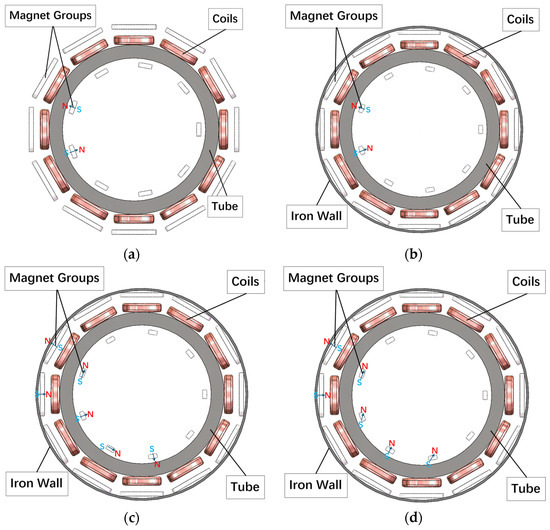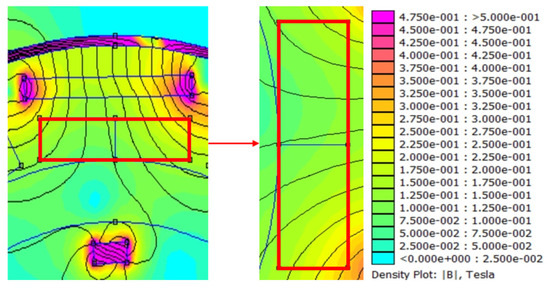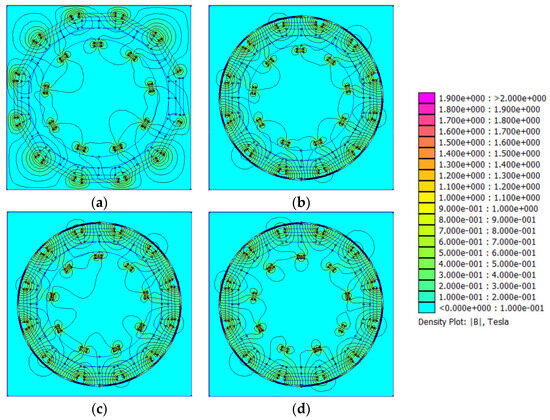Abstract
Wireless and battery-less sensor nodes are pivotal in the future of technology, particularly for continuous monitoring and minimizing maintenance costs. These nodes are especially critical in large-scale agricultural systems, where they enable tasks such as detection, identification, and fertilization, so it is important that self-powered wireless sensors operate reliably. This paper presented an electromagnetic generator within a novel energy harvester to investigate how the power density and efficiency can be improved by optimizing the magnet arrangement and orientation. Four designs are proposed with different magnet orientations and an iron steel plate for flux concentrating. The finite element magnetic method (FEMM) is mainly used to simulate the fine-tuning of the magnet arrangement combined with MATLAB and some mathematical methods to find a suitable magnet arrangement. The results show that, by increasing the number of magnets to nine, adding a pure iron wall, and using a Halbach array, the magnetic flux density can be increased by 1.92 times.
1. Introduction
Wireless sensors are extensively utilized across various applications, with multiple methods available for energy harvesting, including electromagnetic [1], piezoelectric [2], and triboelectric technologies [3]. Agriculture, being a critical driver of economic, commercial, and technological development in any emerging nation, has increasingly benefited from cutting-edge technological advancements and innovations aimed at improving both the quality and yield of agricultural products [4]. The expansion of wireless sensor networks (WSNs) has made it easier to monitor large-scale modern farms. In a smart irrigation system, various sensors, such as temperature monitors and flow meters, can be powered through renewable energy sources harvested from the environment. By employing WSN technology, a hybridized energy harvester driven by rotating waterpower can be incorporated to create a self-sufficient, intelligent agricultural monitoring system.
Despite these advancements, significant challenges remain, particularly in remote areas, where regularly replacing batteries or installing and maintaining power lines for electronic devices is both labor-intensive and costly [5]. This research primarily focuses on maximizing the power harvested using various methods that exploit water flow motion and temperature differences within an irrigation pipe. The water flow harvesting component employs a turbine with strategically positioned magnets, which efficiently convert the turbine’s rotational energy into electrical energy via coils [6]. This paper specifically examines an electromagnetic energy harvester, investigating how to optimize the magnetic arrangement within the generator using finite element analysis. The goal is to enhance power density and efficiency, enabling more effective powering of wireless sensors in agricultural applications.
2. Design
The electromagnetic generator consists of groups of coils, magnets, and a turbine. Faraday’s Law states that a fluctuating magnetic field induces voltage in a circuit [6]. When the turbine rotates, the magnets and coils rotate with it, causing a change in magnetic flux that could convert the energy of the water flow into electrical energy. To maximize the magnetic flux concentrated on the magnet arrangements, many factors such as the number of the magnets need to be considered. Four main designs are proposed as shown in Figure 1.

Figure 1.
Model of the designs: (a) Design1; (b) Design 2; (c) Design 3.1; (d) Design 3.2.
2.1. Design 1: Increase the Number of Magnets
Research indicates that odd blade designs are more common and efficient, while even symmetrical blade arrangements can result in an unbalanced fan and increased resonance [7]. According to preliminary evaluations, fans usually have seven or nine blades, with diameter limits. The design of the inner ring magnets has also been optimized from 3 mm diameter to 2 mm diameter, which reduces the gap and allows for a denser arrangement. The thickness of the coils is also adjusted for increasing the coils, and the design also introduces many larger diameter outer coil magnets.
Figure 1a shows a total of nine cylindrical magnets inside the tube located around the circle with a diameter of 28 mm, whose lower circular diameter is 2 mm, and the thickness of the cylinder is 1 mm (ϕ 2 mm × 1 mm). And outside the tube, around the circle with a diameter of 38 mm, there is a group of twelve coils of ϕ 9 mm × 2 mm, corresponding with twelve cylindrical outer magnets of ϕ 10 mm × 1 mm arranged around the circle with a diameter of 44 mm.
2.2. Design 2: Add an Outer Pure Iron Ring Wall
A pure iron ring can be added to the outermost part of the magnet, as shown in Figure 1b. Due to the high permeability of the pure iron ring, which means that they can channel magnetic lines of force more easily [8], when the magnetic lines of force pass through the pure iron ring, they are able to be concentrated, creating a stronger magnetic field inside it. Reducing the likelihood of the lines of force leaking out of the system is another important advantage, thus retaining more of the lines of force in the useful working area.
In this design, a pure iron ring wall with a thickness of 0.5 mm is added at the position that the circle diameter is 49 mm, together forming the whole structure of 50 mm.
2.3. Design 3: Magnet Arrangement in a Halbach Array
The Halbach Array uses a special arrangement of magnets to enhance the field strength per unit direction, aiming to produce the strongest magnetic field with the smallest number of magnets [9]. The two simplest Halbach Array detailed arrangements and their intended effects are shown in Figure 1c,d.
The Halbach Array is applied in the inner magnets’ arrangement, with a 90-degree and a 45-degree rotation in each magnet direction. The outer magnets follow the reverse direction arrangement, which is consistent with all of the above.
3. Results Analysis
Finite element magnetic method (FEMM) was used in conjunction with MATLAB R2023b to conduct the analysis. After drawing the entire magnetic field simulation, the entire device is operating under rotating motion, making it rotate 360 times to cover one revolution. To acquire a more accurate magnetic flux density produced by the magnet’s rotation in the coil, each coil’s magnetic flux density can be determined by taking the absolute average value after scanning the coil area multiple times; Figure 2 shows the FEMM pattern on the coil.

Figure 2.
FEMM simulation results for coil regions.
Results Analysis
The data from Table 1 show that the magnetic field strength can be effectively modulated by altering the number of magnets, incorporating metallic materials, or adjusting the magnet configuration, and the FEMM simulation results diagrams are shown in Figure 3.

Table 1.
Design and the FEMM simulation results.

Figure 3.
FEMM simulation results diagrams with materials and detailed arrangements: (a) Design1; (b) Design 2; (c) Design 3.1; (d) Design 3.2.
Among these, the design adding a pure iron wall stands out as the most effective, achieving the highest growth. While there is a negligible difference between Designs 3, this could be attributed to the similar arrangements. Design 3.1 achieved a substantive enhancement to 0.1902 T, which is increased by 1.92 times compared to Design 1.
However, despite the improvement, Design 3.1 remains a conceptual idealization based on the original setup. For practical implementation, a comprehensive evaluation of additional factors such as cost, feasibility, and operational stability must be conducted alongside magnetic flux density considerations. Among the designs, the Halbach Array might be unprocurable as it only offers tiny improvements through a too difficult operation. This array was considered in the idealized designs but has not been fully realized beyond the theoretical phase.
4. Conclusions
This design is based on the improvement of the electromagnetic part of the energy harvester designed to support the application of wireless sensor networks. The results show that the flux density is improved by increasing the number of magnets, adding pure iron walls, and applying a Halbach Array. However, the ideal design requires further considerations, and future work will aim to address these, with a view to achieving more efficient and practical energy harvesting systems.
Author Contributions
Conceptualization, C.K.T.; methodology, J.C. and T.X.; software, J.C. and T.X.; validation, J.C.; formal analysis, J.C.; investigation, J.C.; resources, C.K.T.; data curation, J.C.; writing—original draft preparation, J.C., T.X., D.Y. and J.L.; writing—review and editing, J.C., T.X. and C.K.T.; visualization, C.K.T.; supervision, C.K.T.; project administration, C.K.T. All authors have read and agreed to the published version of the manuscript.
Funding
This research received no external funding.
Institutional Review Board Statement
Not applicable.
Informed Consent Statement
Not applicable.
Data Availability Statement
The data presented in this study are available upon request from the corresponding author.
Conflicts of Interest
The authors declare no conflicts of interest.
References
- Foong, F.M.; Thein, C.K.; Yurchenko, D. A two-stage electromagnetic coupling and structural optimisation for vibration energy harvesters. Smart Mater. Struct. 2020, 29, 085030. [Google Scholar] [CrossRef]
- Brusa, E.; Carrera, A.; Delprete, C. A Review of Piezoelectric Energy Harvesting: Materials, Design, and Readout Circuits. Actuators 2023, 12, 457. [Google Scholar] [CrossRef]
- Zhao, R.; Zhang, Z.; Bai, X.; Wang, H.; Zhang, H.; Hao, J.; Wang, C. A review of the research on triboelectric separation technology. Miner. Eng. 2024, 216, 108901. [Google Scholar] [CrossRef]
- Bade, A.; Suresh Kumar, M. Wireless Sensor Network-Based Agriculture Field Monitoring Using Fuzzy Logic. In Proceedings of the International Conference on Futuristic Communication and Network Technologies, Chennai, Tamil Nadu, India, 10–11 December 2021; Springer: Berlin/Heidelberg, Germany, 2021. [Google Scholar]
- Qian, J.; Jing, X. Wind-driven hybridized triboelectric-electromagnetic nanogenerator and solar cell as a sustainable power unit for self-powered natural disaster monitoring sensor networks. Nano Energy 2018, 52, 78–87. [Google Scholar] [CrossRef]
- Liu, H.; Zhang, J.; Shi, Q.; He, T.; Chen, T.; Sun, L.; Dziuban, J.A.; Lee, C. Development of a Thermoelectric and Electromagnetic Hybrid Energy Harvester from Water Flow in an Irrigation System. Micromachines 2018, 9, 395. [Google Scholar] [CrossRef] [PubMed]
- Qin, D.; Huang, Q.; Pan, G.; Chao, L.; Luo, Y.; Han, P. Effect of the odd and even number of blades on the hydrodynamic performance of a pre-swirl pumpjet propulsor. Phys. Fluids 2022, 34, 035120. [Google Scholar] [CrossRef]
- Weber, F.; Broeckmann, C.; Züch, V.; Jacobs, G.; Zimmermann, J.; Schröder, K.-U.; Bami, Y.; Jakumeit, J.; Bodenburg, M. Multi-domain optimization of cast iron components in wind turbines. Forsch. Im Ingenieurwesen 2023, 87, 39–50. [Google Scholar]
- Guo, S.; Gao, S.; Jin, L.; Du, X.; Wu, Q.; Shang, J. Characteristic Analysis, Simulation, and Experimental Comparison of Two Kinds of Circular Magnet Array in Energy Harvesting. Appl. Sci. 2022, 12, 1962. [Google Scholar] [CrossRef]
Disclaimer/Publisher’s Note: The statements, opinions and data contained in all publications are solely those of the individual author(s) and contributor(s) and not of MDPI and/or the editor(s). MDPI and/or the editor(s) disclaim responsibility for any injury to people or property resulting from any ideas, methods, instructions or products referred to in the content. |
© 2024 by the authors. Licensee MDPI, Basel, Switzerland. This article is an open access article distributed under the terms and conditions of the Creative Commons Attribution (CC BY) license (https://creativecommons.org/licenses/by/4.0/).